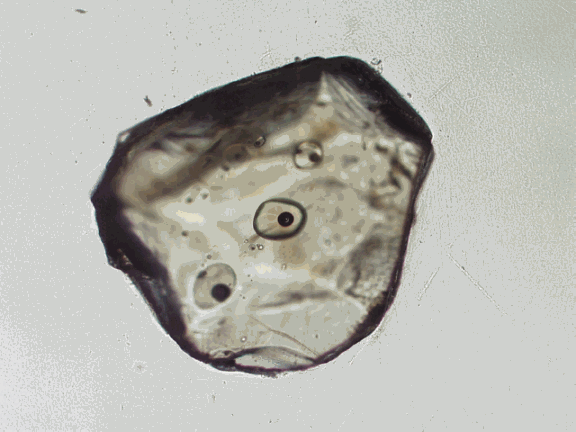A new technique that employs high-brightness x-ray beams has enabled scientists to play “detective” and solve a debate about the origins of a three-billion-year-old rock fragment. In the study, published in the journal Nature, researchers using the U.S. Department of Energy’s Advanced Photon Source (APS) at Argonne National Laboratory describe the new technique and show how it can be used to analyze tiny samples of molten rock called magma, yielding important clues about the Earth's early history.
The researchers, from Imperial College London, the University of Tasmania, Australian National University, and the University of Chicago, used the University of Chicago GeoSoilEnviroCARS (GSECARS) 13-ID-C x-ray beamline at the APS to investigate the chemistry of a rare type of magmatic rock called a “komatiite,” which was preserved for billions of years in crystals. It has been difficult to discover how komatiites formed because earlier analytical techniques lacked the power to provide key pieces of information.
Thanks to the new technique — iron K-edge x-ray absorption near-edge structure spectroscopy — the team found that komatiites were formed in the Earth's mantle (the region between the crust and the core) more than 2.7 billion years ago, at temperatures of around 1,700 degrees Celsius.
These findings dispel a long-held theory, which suggested that komatiites were formed at much cooler temperatures, and also yields an important clue about the mantle's early history: the mantle has cooled by 300 degrees Celsius over the 2.7-billion-year period
Lead researcher Andrew Berry, from the Imperial College London Department of Earth Science and Engineering, says more research needs to be done to fully understand the implications of this finding. However, he believes the new technique will enable scientists to uncover more details about the Earth's early history.
"It has long been a 'holy grail' in geology to find a technique that analyzes the chemical state of tiny rock fragments,” said Berry, “because they provide important geological evidence to explain conditions inside the early Earth. This research resolves the controversy about the origin of komatiites and opens the door to the possibility of new discoveries about our planet's past."
In particular, Berry believes this technique can now be used to explain Earth's internal processes such as the rate at which its interior has been cooling, how the forces affecting the Earth's crust have changed over time, and the distribution of radioactive elements that internally heat the planet. He believes this information could then be used to build new, detailed models to explain the evolution of the planet.
"It is amazing that we can look at a fragment of magma only a fraction of a millimetre in size and use it to determine the temperature of rocks tens of kilometres below the surface billions of years ago. How's that for a piece of detective work?"
Contact: A.J. Berry, ([email protected]
See: Andrew J. Berry, Leonid V. Danyushevsky, Hugh St. C. O'Neill, Matt Newville, and Stephen R. Sutton, “Oxidation state of iron in komatiitic melt inclusions indicates hot Archaean mantle,” Nature 455, 960 (16 October 2008). DOI:10.1038/nature07377
This research was supported by the Australian Research Council (DP0450252), the Access to Major Research Facilities Programme (funded by the Commonwealth of Australia), and the Natural Environment Research Council. GSECARS is supported by the U.S. National Science Foundation (EAR-0622171) and the U.S. Department of Energy (DE-FG02-94ER14466). The authors also acknowledge the Australian National Beamline Facility (Photon Factory) for assistance with XANES experiments that provided the foundations for the present study.
Use of the Advanced Photon Source was supported by the U.S. Department of Energy, Office of Science, Office of Basic Energy Sciences, under contract no. DE-AC02-06CH11357.
The nation's first national laboratory, Argonne conducts leading-edge basic and applied scientific research in virtually every scientific discipline. Argonne researchers work closely with researchers from hundreds of companies, universities, and federal, state and municipal agencies to help them solve their specific problems, advance America 's scientific leadership and prepare the nation for a better future. With employees from more than 60 nations, Argonne is managed by UChicago Argonne, LLC for the U.S. Department of Energy's Office of Science.
The original press release can be found here.

